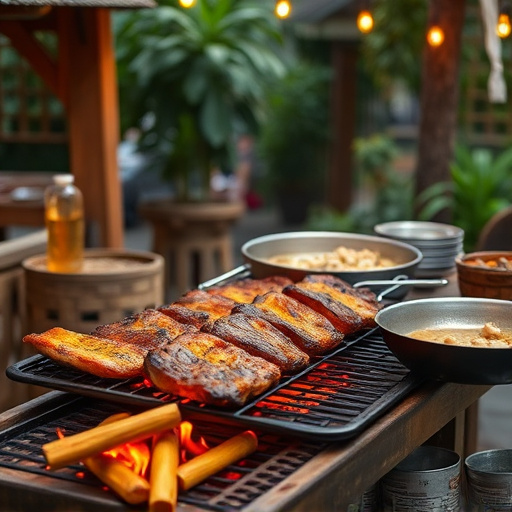Crafting delicious BBQ skewers involves a variety of proteins (chicken, beef) and vegetables, offering endless flavor combinations. Marinate ingredients for enhanced taste, using techniques like dry rubs or saucy marinades. Even cutting and cooking is key; alternate protein and veggies on skewers, pre-cooking partially to ensure even grilling. Grill at medium-high heat, adjusting times based on meat type. Serve with dips and sauces, crispy sides, and creative presentations for a standout dish. Store leftovers in airtight containers within 3-4 days and reheat safely in the oven or on the grill. BBQ skewers are nutritious and versatile, catering to various dietary needs.
Discover the ultimate guide to creating mouthwatering BBQ skewers with our versatile recipe. Explore a world of flavors by combining chicken, beef, or veggies on your skewers – each offering unique textures and tastes that’ll satisfy any palate. From choosing the perfect combinations to mastering marination techniques, grilling perfection, and serving ideas, this comprehensive article ensures every aspect of your skewer experience is elevated. Unleash your inner BBQ master and create a delicious and memorable meal with our detailed step-by-step guide.
- Choosing Your Skewer Combinations (Discuss the versatility with chicken, beef, and veggies; their flavors and textures)
- Marinating for Maximum Flavor (Explain different marination techniques, types of sauces, and how they enhance each type of skewer)
- Skewer Preparation Tips (Cover cutting techniques, skewer arrangements, and pre-cooking methods to ensure even cooking)
- Grilling Techniques for Perfect BBQ Skewers (Guide on grilling times, heat control, and signs of doneness for each ingredient)
- Accompanying Dips and Sauces (Explore complementary sauces, dips, and sides to enhance the skewer experience)
- Creative Skewer Presentation Ideas (Offer suggestions for plating and serving skewers for different occasions)
- Storage and Reheating Tips (Provide advice on how to store leftovers and reheat skewers safely)
- Nutritional Insights and Varieties (Discuss the health benefits of each ingredient, potential dietary swaps, and customizable options)
Choosing Your Skewer Combinations (Discuss the versatility with chicken, beef, and veggies; their flavors and textures)
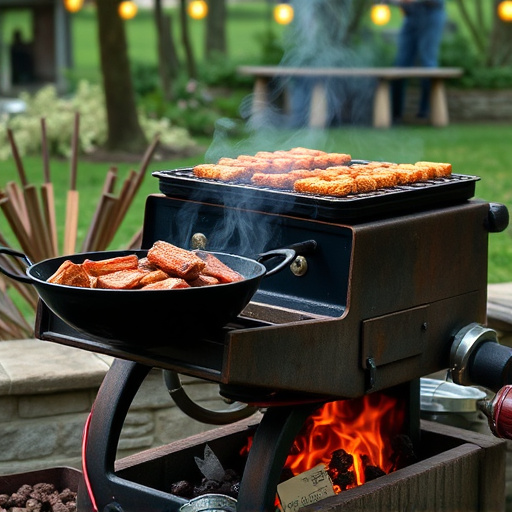
When it comes to crafting delicious BBQ skewers, the options are as endless as your imagination. The beauty lies in the combination of ingredients, where chicken, beef, and vegetables offer a versatile canvas for flavors and textures. Chicken, with its tender meat and neutral taste, acts as a chameleon, soaking up marinades and spices. It pairs beautifully with sweet and savory sauces, and its versatility allows for creative combinations—from classic teriyaki to tropical fruit-infused glazes.
Beef skewers bring a hearty, robust quality to the table. Whether it’s marinated sirloin or flavorful beef brisket, the rich, meaty taste adds depth to your BBQ experience. Vegetables, the unsung heroes, offer a burst of color and crunch. From juicy cherry tomatoes and bell peppers to earthy mushrooms and zesty zucchini, they contribute unique textures and flavors, creating a vibrant contrast on each skewer.
Marinating for Maximum Flavor (Explain different marination techniques, types of sauces, and how they enhance each type of skewer)

Marinating is a key step in elevating the flavor profile of your BBQ skewers recipe, whether you’re opting for chicken, beef, or veggie varieties. It involves submerging your ingredients in a mixture of flavors, often consisting of oils, acids, spices, and herbs, which helps to tenderize the meat and infuse it with rich, complex tastes.
There are several effective marination techniques to explore. For instance, dry marinating involves coating your skewers with a spice rub, allowing the robust flavors of coarsely ground peppers, salts, paprika, garlic powder, and herbs like rosemary or thyme to adhere directly to the food. On the other hand, wet marinating uses a liquid base such as soy sauce, olive oil, or lemon juice, which not only adds moisture but also facilitates penetration deeper into the meat’s fibers. Sauces like teriyaki, BBQ, or chimichurri offer an even richer experience, balancing between acidity and sweetness while adding a smoky or herby note to your skewers. Experimenting with these different types of sauces can transform your BBQ skewers recipe into a delightful culinary adventure.
Skewer Preparation Tips (Cover cutting techniques, skewer arrangements, and pre-cooking methods to ensure even cooking)

When preparing BBQ skewers, there are a few key tips to keep in mind for the best results. First, focus on cutting techniques – ensure your chicken, beef, or vegetables are cut into uniform pieces to guarantee even cooking. Cubes or bite-sized chunks work best, as they cook evenly and quickly. Next, consider skewer arrangements: alternate proteins and veggies for a balanced meal, and use metal or wooden skewers depending on the ingredients. Metal skewers are ideal for tough cuts of meat, while wooden skewers are better for vegetables to avoid burning.
Pre-cooking is also essential for even BBQ skewer preparation. For best results, partially cook your ingredients before threading them onto the skewers. This can be done by grilling or sautéing in a pan for a few minutes until almost cooked through, but still slightly undercooked at the center. This step ensures that all parts of the skewer will be cooked to perfection when grilled, preventing overdone or undercooked sections.
Grilling Techniques for Perfect BBQ Skewers (Guide on grilling times, heat control, and signs of doneness for each ingredient)
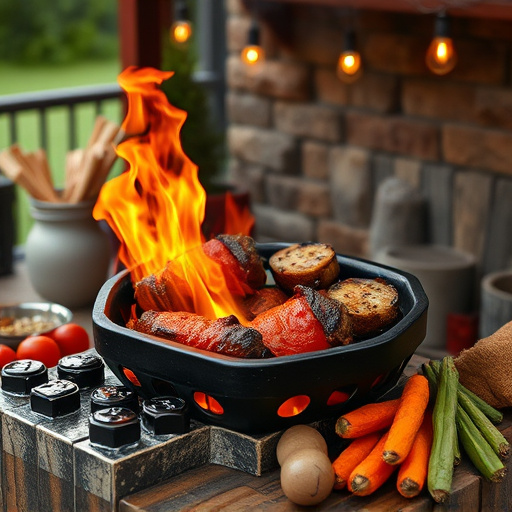
Grilling is an art, and achieving perfectly cooked BBQ skewers requires a bit of practice and attention to detail. When grilling chicken or beef skewers, temperature control is key. Preheat your grill to medium-high heat, aiming for around 400-450°F (200-230°C). This ensures even cooking and prevents the meat from drying out. For chicken, allow approximately 10-12 minutes of direct grilling time per inch of thickness, ensuring it reaches an internal temperature of 165°F (74°C) to kill any potential bacteria. Beef skewers benefit from a slower cook at first, searing for 3-4 minutes on each side to develop flavor, then finishing them off indirect heat for about 8-10 minutes or until they reach your desired doneness, typically around 125-135°F (52-57°C) for medium-rare. Veggie skewers may require a bit less time due to their lower density; keep an eye on them as they cook quickly over high heat. Look for signs of doneness such as charred edges and no pink in the center, ensuring your BBQ skewers are not only delicious but also safely prepared.
Accompanying Dips and Sauces (Explore complementary sauces, dips, and sides to enhance the skewer experience)

Enhance your BBQ Skewers Recipe with a variety of dips and sauces to elevate the dining experience. Consider creamy options like tzatziki or pesto, offering a refreshing contrast to the grilled meats or vegetables. For a tangy twist, lemon-garlic sauce or a spicy kick from chili-infused oil can be excellent choices.
Complement these with crunchy sides like fresh vegetable salads or crispy fried onions. Alternatively, offer warm side dishes such as garlic bread or roasted potatoes to balance the cold dips and sauces. The key is to pair flavors that either complement or contrast with your skewers, ensuring each bite is a delightful adventure for your taste buds.
Creative Skewer Presentation Ideas (Offer suggestions for plating and serving skewers for different occasions)
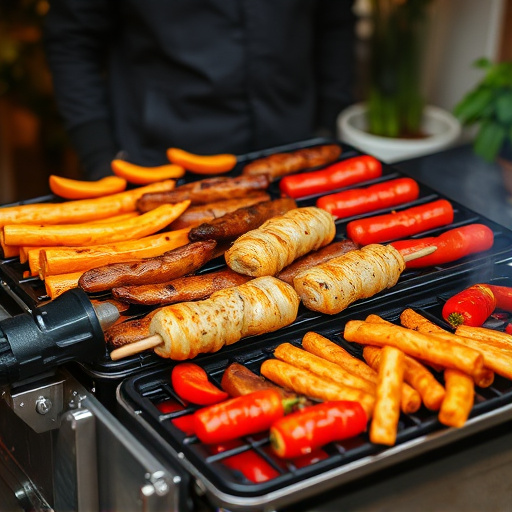
Add a touch of artistry to your BBQ skewers with creative presentation ideas, perfect for any occasion. For elegant dinner parties, consider arranging skewers on a bed of fresh herbs and serving them with a dipping sauce in miniature cups. This not only elevates the dish aesthetically but also encourages guests to interact with their food.
For a more casual gathering or summer picnic, skewer veggies or fruits alongside meat and present them on a large platter with various sauces and condiments in small bowls nearby. This allows for customization and can be a fun activity for kids as well. Simple yet effective, these presentation ideas make your BBQ skewers recipe stand out while catering to different preferences and occasions.
Storage and Reheating Tips (Provide advice on how to store leftovers and reheat skewers safely)

To store your delicious BBQ skewer leftovers, place them in an airtight container and refrigerate within 2 hours of cooking to prevent bacterial growth. It’s best to consume within 3-4 days for optimal flavor and texture.
When ready to reheat, preheat your oven or grill to 350°F (180°C). Place the skewers on a baking sheet, cover them loosely with foil, and warm for 10-15 minutes, or until heated through. Alternatively, you can grill them directly over medium heat for 2-3 minutes per side, ensuring they stay tender and juicy. Always reheat thoroughly to ensure food safety, especially when handling chicken or beef.
Nutritional Insights and Varieties (Discuss the health benefits of each ingredient, potential dietary swaps, and customizable options)
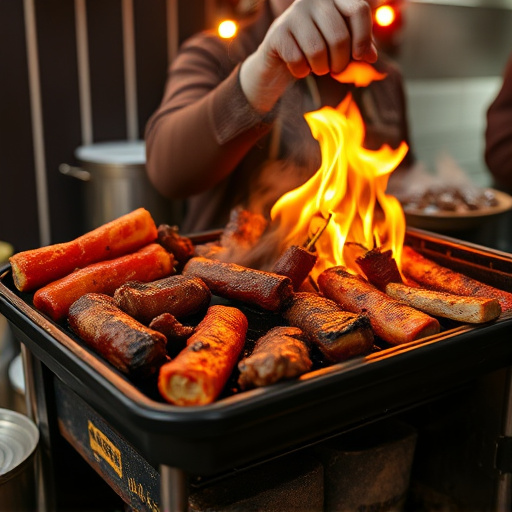
Nutritional Insights and Varieties
BBQ skewers, whether featuring chicken, beef, or vegetables, offer a delightful blend of flavors and textures while packing significant nutritional value. Chicken is a lean protein source, high in vitamins B6 and B12, zinc, and selenium, contributing to a robust immune system and overall health. It’s an excellent choice for those watching their saturated fat intake due to its low-fat content compared to red meats.
For beef skewers, opt for lean cuts like sirloin or tenderloin to reduce the amount of saturated fat. Beef is rich in iron, vitamin B12, and zinc, all essential for energy production, blood health, and a strong immune system. Veggie skewers bring a burst of plant-based nutrition, packed with vitamins A, C, and K, as well as folate and fiber from vegetables like bell peppers, zucchini, and mushrooms. These fiber-rich options can help support digestive health and contribute to feelings of fullness, making them a satisfying choice for those adhering to vegetarian or vegan diets. Customizable swaps include using tofu for protein in veggie skewers or experimenting with different herbs and spices to adjust flavors without compromising on nutritional benefits.
